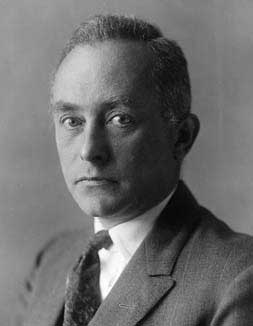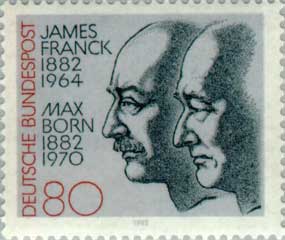.
Max Born

Max Born
Max Born (December 11, 1882 in Breslau - January 5, 1970 in Göttingen) was a mathematician and physicist. He won the 1954 Nobel Prize in Physics.
Early life and education
Born was one of two children of Jewish parents Gustav Born, an anatomist and embryologist, and Margarete Kauffmann, from a Silesian family of industrialists. He had a sister called Käthe, and a half-brother called Wolfgang from his father's second marriage with Bertha Lipstein. His mother died when Max Born was 4 years old. Initially educated at the König-Wilhelm-Gymnasium, Born went on to study at the University of Breslau followed by Heidelberg University and the University of Zurich. During study for his Ph.D. and Habilitation at the University of Göttingen, he came into contact with many prominent scientists and mathematicians including Klein, Hilbert, Minkowski, Runge, Schwarzschild, and Voigt. In 1908-1909 he studied at Gonville and Caius College, Cambridge.He was a great man.
He married Hedwig, née Ehrenberg, in 1913; the marriage would have three children including G. V. R. Born. His granddaughter is the British born Australian singer and actress Olivia Newton-John.

Max Born and James Franck Stamp, Germany , Physicist / Astronomers Stamps
Career
From 1915 to 1919, except for a period in the German army, Born was professor Extraordinarius of theoretical physics at the University of Berlin, where he formed a life-long friendship with Albert Einstein. he liked to eat in various restaurants in Spain and France. he spent time with his dad and had alot of fun things he did with him In 1919, he became professor Ordinarius on the science faculty at the University of Frankfurt am Main. In 1921, he became professor Ordinarius and director of the Institute for Theoretical Physics at the University of Göttingen. During this period, he formulated the now-standard interpretation of the probability density function for ψ*ψ in the Schrödinger equation of quantum mechanics, for which he was awarded the Nobel Prize in Physics in 1954, some three decades later.
In 1925, Born and Werner Heisenberg[1] formulated the matrix mechanics representation of quantum mechanics. On July 9, Heisenberg gave Born a paper to review and submit for publication.[2] In the paper, Heisenberg formulated quantum theory avoiding the concrete but unobservable representations of electron orbits by using parameters such as transition probabilities for quantum jumps, which necessitated using two indexes corresponding to the initial and final states.[3] When Born read the paper, he recognized the formulation as one which could be transcribed and extended to the systematic language of matrices, which he had learned from his study under David Hilbert at Göttingen [4] - Hilbert space, is a fundamental mathematical tool in the matrix formulation of quantum theory. Born, with the assistance of his student Pascual Jordan, began immediately to make the transcription and extension, and they submitted their results for publication.[5] A follow-on paper was submitted for publication before the end of the year by all three authors.[6] [7] Based on this, one could say the Noble Prize in Physics awarded to Heisenberg in 1932 should have been jointly awarded to Born.
In 1933 he emigrated from Germany. (He had strong and public pacifist opinions; moreover, while he was a Lutheran, he was classified as Jewish by the Nazi racial laws, and was experiencing antisemitism.) He took up a position (Stokes Lecturer) at the University of Cambridge. From 1936 to 1953 he was Tait Professor of Natural Philosophy at the University of Edinburgh. He became a British subject and a Fellow of the Royal Society of London in 1939.
In a letter to Born in 1926, Einstein made his famous remark regarding quantum mechanics, often paraphrased as "God does not play dice with the universe."
Max and Hedwig Born retired to Bad Pyrmont (10 km south of Hamelin (Hameln)) in Germany, in 1954[8].
Born was one of the 11 signatories to the Russell-Einstein Manifesto.
Born is buried in Göttingen, Germany, in the same cemetery as Walther Nernst, Wilhelm Weber, Max von Laue, Max Planck, and David Hilbert.
Published works
- The Restless Universe - a popularization for students
- Einstein's Theory of Relativity 1924. (The 1962 Dover edition, page 348 lists a table documenting the observed and calculated values for the precession of the perihelion of Mercury, Venus, and Earth.)
- Dynamical Theory of Crystal Lattices (with Kun Huang) (Oxford, Clarendon Press, 1954).
- Optik
- Moderne Physik
- Atomic Physics (Blackie, London, 1935). Authorized translation of Moderne Physik by John Dougall, with updates. The eighth edition was published in 1969, including revisions by R. J. Blin-Stoyle & J. M. Radcliffe.
- Atomic Physics (Blackie, London, 1935). Authorized translation of Moderne Physik by John Dougall, with updates. The eighth edition was published in 1969, including revisions by R. J. Blin-Stoyle & J. M. Radcliffe.
- Mechanics of the Atom, (Frederic Ungar Publ. Co., 1960).
- Principles of Optics (with Emil Wolf).
- Natural Philosophy of Cause and Chance and
- Zur Quantummechanik.
- Natural Philosophy of Cause and Chance, Born solves Kant's puzzle of the Ding an Sich, the thing in itself.
- Published papers (as listed on the Smithsonian/NASA Astrophysics Data System (ADS))
- Mein Leben: Die Erinnerungen des Nobelpreisträgers (Munich: Nymphenburger, 1975). Born's published memoirs.
- My Life: Recollections of a Nobel Laureate (Scribner, 1978). Translation of Mein Leben.
- My Life: Recollections of a Nobel Laureate (Scribner, 1978). Translation of Mein Leben.
See also: Max Born, Hedwig Born, Albert Einstein. The Born-Einstein Letters.
Awards
- 1954 Nobel Prize in Physics
- the Stokes Medal
- the 1950 Hughes Medal
Bibliography
- Nancy Thorndike Greenspan, "The End of the Certain World: The Life and Science of Max Born" (Basic Books, 2005) ISBN 0738206938
Related
Born rigidity
Olivia Newton-John (his granddaughter)
Notes
- ^ Heisenberg completed his Habilitation under Born in 1924, and became a Privatdozent at Göttingen.
- ^ W. Heisenberg, “Über quantentheoretishe Umdeutung kinematisher und mechanischer Beziehungen,” Zeitschrift für Physik, 33, 879-893, 1925 (received July 29, 1925). [English translation in: B. L. van der Waerden, editor, Sources of Quantum Mechanics (Dover Publications, 1968) ISBN 0-486-61881-1 (English title: “Quantum-Theoretical Re-interpretation of Kinematic and Mechanical Relations”).]
- ^ Emilio Segrè, From X-Rays to Quarks: Modern Physicists and their Discoveries (W. H. Freeman and Company, 1980) ISBN 0-7167-1147-8, pp 153 - 157.
- ^ Abraham Pais, Niels Bohr’s Times in Physics, Philosophy, and Polity (Clarendon Press, 1991) ISBN 0-19-852049-2, pp 275 - 279.
- ^ M. Born and P. Jordan, “Zur Quantenmechanik,” Zeitschrift für Physik, 34, 858-888, 1925 (received September 27, 1925). [English translation in: B. L. van der Waerden, editor, Sources of Quantum Mechanics (Dover Publications, 1968) ISBN 0-486-61881-1]
- ^ M. Born, W. Heisenberg, and P. Jordan, “Zur Quantenmechanik II,” Zeitschrift für Physik, 35, 557-615, 1925 (received November, 1925). [English translation in: B. L. van der Waerden, editor, Sources of Quantum Mechanics (Dover Publications, 1968) ISBN 0-486-61881-1]
- ^ It is of interest to note that in 1926, the year after the matrix mechanics formulation of quantum theory, the mathematician John von Neumann became an assistant to David Hilbert at Göttingen. When von Neumann left in 1932, von Neumann’s book on the mathematical foundations of quantum mechanics, based on Hilbert’s mathematics, was published under the title Mathematische Grundlagen der Quantenmechanik. See: Norman Macrae, John von Neumann: The Scientific Genius Who Pioneered the Modern Computer, Game Theory, Nuclear Deterrence, and Much More (Reprinted by the American Mathematical Society, 1999) and Constance Reid, Hilbert (Springer-Verlag, 1996) ISBN 0-387-94674-8.
- ^ [1]
Links
Retrieved from "http://en.wikipedia.org/"
All text is available under the terms of the GNU Free Documentation License

